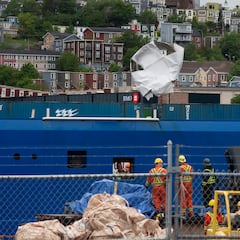The ‘iron-eating bacteria’ that is devouring the Titanic: this is how rusticles are formed
Halomonas titanicae is feeding on the Titanic’s iron and consuming the ship gradually. In the process is creates icicle-like formations called rusticles.

The death of the five people on board of the Titan has caused even the most daring people to wonder if it is worth it to visit the site of the Titanic shipwreck in the North Atlantic. A decision that seems to have a deadline, because several scientists discovered a bacterium that is progressively destroying some parts of the ship, such as the captain’s cabins.
The attack by the bacteria, added to sea currents and weather conditions, have led many experts to predict that by 2050 The Titanic will be devoured in its entirety, leaving only a story of tragedy around it.
Halomonas titanicae
This was stated by the youtuber Alan Estrada in one of the videos he made for his channel on an expedition aboard the Titan. “The formations, which look like rust, and which now form the Titanic’s new skin, are actually a bacterium discovered in 2010 and called Halomonas titanicae, which feeds on iron and gradually consumes the ship,” he explained while images of the trip he made in 2022 could be seen, after a first failed attempt a year earlier.
More specifically, this bacterium devours metal structures, adheres to steel surfaces and mixes with other microorganisms to accelerate corrosion and disappearance. In the process, icicle-like structures are formed which are called ‘rustciles’. It should be noted that these remains of the Titanic lie almost 4,000 meters at the bottom of the sea, in the dark salty waters of the North Atlantic.
Able to survive in extreme conditions
The company OceanGate, responsible for the failed Titan expedition, shared an article on its Twitter account last May in which it explained how the presence of the bacteria was affecting the hull of the Titanic. Beyond its link to the Titanic, the truth is that this bacterium is considered particularly rugged due to the extreme environmental conditions in which it was found.
These conditions make the bacterium an organism capable of surviving in a context from which no living being could get out alive. What's more, these types of life forms are used by scientists as a model of what could exist on other planets or satellites of the solar system.
Did you know that the colorful "rusticles" that grow on the hull of Titanic are created by a unique bacteria slowly eating the wreck? Halomonas titanicae eats the iron from the hull and leaves the rusticles behind.
— OceanGate Expeditions (@OceanGateExped) May 23, 2023
Read: https://t.co/vnE9K7bp5Y #TitanicTuesday
“The Titanic will be here for a long time”
To date scientists have been able to understand how Halomonas bacteria thrive in a potentially hostile environment, such as the site of the sunken Titanic. However, their role in the formation of rust is not clear and this causes a lot of concern, since these bacteria constitute a serious threat to oil rigs and other iron structures located in the deep sea, according to information from Science in School.
Related stories
Today, these organisms have become the subject of scientific research for another reason: to find out how they manage to thrive in conditions with high and variable salinity concentrations. In this context, the content creator showed in his video how the bacteria was destroying the wreckage. “Although the deterioration is significant, the Titanic will be here for a long time,” Estrada said.
In any case, the researchers believe that these iron-eating bacteria could play an important role in the future management of metal waste, by accelerating its decomposition process on the ocean floor as they are doing to the Titanic now. So, in the not too distant future the remains of the historic ship will also perish.

